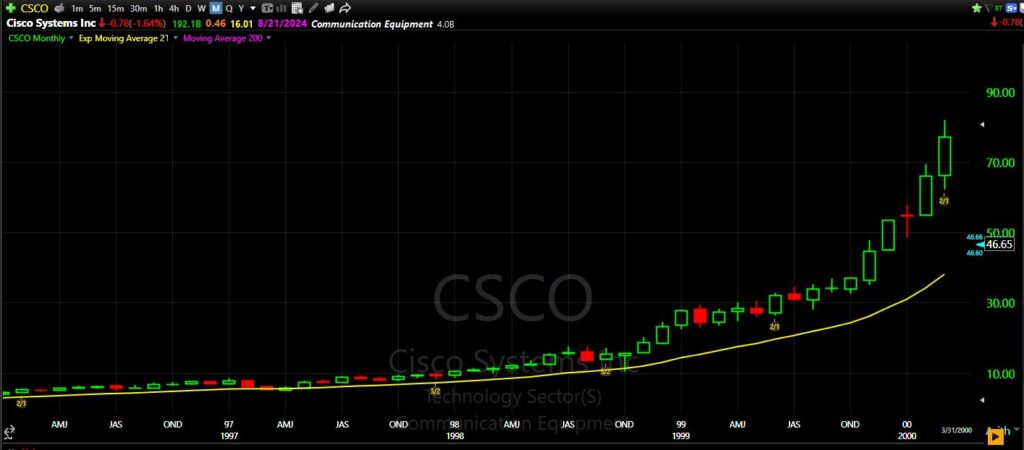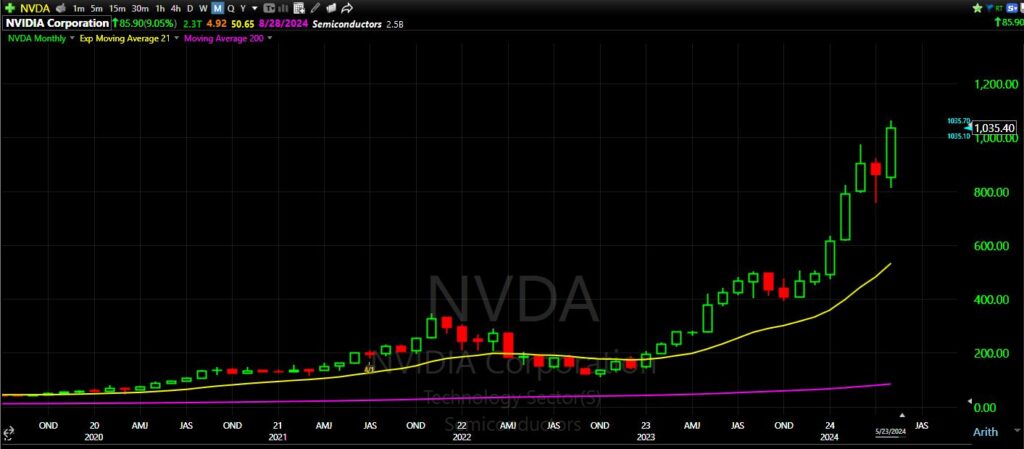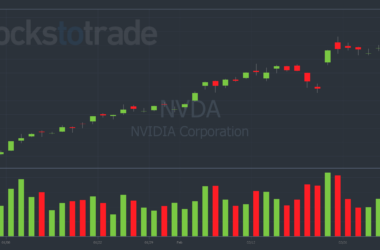Good morning, traders…
Jeff here.
I hope you were paying attention last Thursday, May 23.
Something big happened — an event that gave us big clues as to where the market might be headed soon.
The day after Nvidia Corporation (NASDAQ: NVDA) reported Q1 earnings, the stock shot up 10%.
But that wasn’t the surprising part.
Most people expected the rest of the market to surge following Nvidia’s strong results.
However, the exact opposite happened…
The Dow Jones Industrial Average dropped 600 points (-1.52%) in its worst day since March 2023.
“But the Nasdaq must have been up, right?”
Wrong. The Nasdaq was less red than the Dow, but still down 0.45%.
$NVDA is accounting for over 40% of the move in $SPX today while the broader index is DOWN.
— Tier1 Alpha (@t1alpha) May 23, 2024
Unfortunately, we've been able to say this a few times this year, but this is one of the largest examples of market cap distortion we've seen yet.
Equal weight $RSP is down -0.61%. pic.twitter.com/kjtBHDjL7a
So, why were all of the indexes red when the most important company in the market smashed earnings expectations?
I have my theories. Let’s break them down…
The Key Reversal Day
Thursday was what some would call a key reversal day for the major indexes — a one-day chart pattern where prices sharply reverse during a trend.
In an uptrend like this one, prices open to new highs and then close below the previous day’s closing price.
Thursday was the first time we’ve seen that in quite a while, usually a super bearish sign.
In key reversals, it’s crucial to pay attention to the stocks that aren’t rallying.
Last week’s move saw all of these other tech stocks getting decimated — even sympathy plays to Nvidia (like AMD) — as speculative traders and algorithms sold the red names to buy more Nvidia.
But to get to the bottom of this, we need to start with Nvidia’s earnings results.
Nvidia’s Q1 Earnings Results
Nvidia’s results were solid, there’s no denying that.
The demand for their chips remains strong, for now…
Here are the main points on the financial performance side of things:
- Revenue: NVIDIA reported total revenue of $26.04 billion, significantly surpassing analysts’ expectations of $24.59 billion and representing a 262% increase year-over-year (Nvidia Investor Relations) (MarketBeat).
- Earnings per Share (EPS): The company posted an EPS of $6.12, which exceeded the consensus estimate of $5.14 by $0.98 (MarketBeat).
These are pretty sizeable beats and I’ve gotta hand it to Nvidia for taking advantage of the moment.
But the more I watch this market unfold, the more I believe that’s what this AI rally is: a moment, a flash, a bubble…
Not a sustainable long-term growth picture.
The thing that people don’t get about Nvidia is that these huge gains are unsustainable growth-wise and sales-wise.
Nvidia’s sales will likely collapse at some point as the AI gold rush reaches its saturation point.
Right now, it’s benefitting from every company on earth trying to strike gold with AI.
But once that rush reaches a zenith, Nvidia’s sales will probably crater very quickly.
Even if AI becomes the biggest thing ever — the most profitable sector over the next few decades — the vast majority of companies attempting to capitalize on it will fail miserably.
The exact same thing happened with the early internet…
Dot-Com Deja Vu
I’ve said it before and I’ll say it again…
All of this AI hype feels just like the ‘dot-com’ craze of the late 90s.
If Nvidia is the poster child for the 2024 AI bubble, its dot-com counterpart was Cisco Systems Inc. (NASDAQ: CSCO).
At the beginning of 1998, CSCO was a $10 stock. Just two years later, by April 2001, it traded for $82 — an all-time high that still holds today, 23 years later.
CSCO gained 680% in 2.3 years. Sound familiar? It should…
Since January 2023, Nvidia has gained 597% in 1.3 years.
Look at these monthly charts side by side and tell me they don’t look strikingly similar…


And it’s not just the charts that are similar…
Cisco was running the same kind of business that Nvidia is. Instead of GPUs, it was servers.
Every company that wanted to get in on the early internet was buying servers hand-over-fist from Cisco.
But eventually, when those companies ran out of money, Cisco’s sales plummeted (practically overnight)…
Then look what happened:

Cisco stock dropped over 90% in 2000 as traders rushed to dump the once-beloved darling of the dot-com bubble.
Like desperate patrons trying to flee a burning theater through a single exit door, they couldn’t sell fast enough.
Cisco investors who bought in 2000 with the thesis that the world would be increasingly online were correct.
But they also got terrible entry prices.
This AI move could end similarly, that’s all I’m saying.
Be careful out there.
Happy trading,
Jeff Zananiri
P.S. With the recent market volatility, many traders are all but guaranteed to lose money…
But by following my unique method for finding trade ideas, savvy traders now have the chance to witness double and even triple-digit gains like:
+69% on BKR in 1 Month
+85% on ORCL in 1 Month
+153% on Meta in 1 Month
+210% on WKHS in 1 Month
+423% on COG in 1 Month
(Just to name a few…)*
Discover the key behind my “Calendar Stocks” edge in the markets — CLICK HERE TO GET ACCESS NOW.
*Past performance does not indicate future results



